Maryland Fishing Report – August 31

McKenna Rayne Gingell has good cause to smile after catching this nice Spanish mackerel, one of Maryland’s summer visitor species. Photo courtesy of McKenna Rayne Gingell
Labor Day is almost upon us, and with September comes small changes in weather that will affect fishing in Maryland. Cooler water temperatures will cause some of our summer migrants to start heading south, and local fish species will become more active throughout the day.
This week is our final Striped Bass Fishing Advisory Forecast of the season, but we all know there will still be hot days ahead. Please be aware that such days are stressful on undersized striped bass that you catch and release, and use caution when fishing in hot weather.
Forecast Summary: August 31 – September 6:
Continued warm weather is predicted all this week with daytime temperatures in the upper 80s. There will be stable temperatures and calm winds all week, with a chance of rain and thunderstorms on Monday and Tuesday. Chesapeake Bay surface water temperatures remain in the low 80s. Maryland rivers are currently running in the mid to low 70s. If you are seeking areas with cooler waters, fish the surface early in the day, or fish deeper waters or upwind areas.
At the following locations, adequate oxygen conditions can be found from the surface down to these depth ranges: from the Virginia state line up to the Gooses Reef buoy, 30 feet to bottom; Little Choptank up to the Choptank River, 25 feet to 45 feet; Bloody Point, 15 feet to 35 feet; Bay Bridge, 20 feet to 25 feet; Swan Point, 20 feet; and Still Pond up to the Susquehanna Flats, surface to bottom. Poor deep water oxygen conditions are present in most tributaries, where there is adequate oxygen down to about 20 feet. On the Potomac River, there is adequate oxygen down to 15 feet to 20 feet from the Route 301 Bridge down to the St. Mary’s River. It is likely that in most locations, gamefish will be deeper in the water column to find adequate oxygen and their preferred water temperatures.
Expect average flows for most Maryland rivers and streams all week. There will be above average tidal currents Wednesday and Thursday due to the August 27 new moon.
There will be average water clarity for most of the main Bay and rivers. To see the latest water clarity conditions, check Eyes on the Bay Satellite Maps on the Maryland Department of Natural Resources website.
As always, best fishing areas could be further refined by intersecting them with underwater points, hard bottom, drop-offs, and large schools of baitfish.
For more detailed and up-to-date fishing conditions in your area of the Bay, be sure to check out Eyes on the Bay’s Click Before You Cast.

Tanner Cooper caught this huge northern snakehead while casting along the shoreline in the Middle River. Photo courtesy of Tanner Cooper
The fishing situation at the Conowingo Dam and lower Susquehanna River has been the same – a few striped bass and lots of catfish. The anglers that just won’t give up and enjoy an early morning on the water are catching a few striped bass at dawn by casting poppers and paddletails at the dam pool and along the edges of the Susquehanna Flats.
A mix of flathead, blue, and channel catfish dominate the fishing scene at the dam pool and the lower part of the Susquehanna. Channel catfish and blue catfish will be found in large numbers in adjoining tidal rivers of the upper Bay. Cut bait and a variety of other favored baits will do the trick when used on a simple bottom rig.
The striped bass action picks up in the region around Pooles Island, the various lumps between the two channels, and to the east at Phoenix Shoal. Many are still live lining spot with good results, but a group of anglers are switching to drifting small eels at these locations. Striped bass can also be found at the mouth of the Patapsco River near the Key Bridge, the mouth of the Magothy River, and the Love Point rocks. Jigging at the Love Point rocks and the Key Bridge has also been a worthwhile endeavor. We are still experiencing the warm water conditions that can cause stress on striped bass that are released, so please use the utmost care since these sub-legal fish represent the future of striped bass fishing. Visit the DNR website for responsible catch-and-release procedures and for tips on using circle hooks.
Breaking fish in the form of small striped bass and bluefish are being reported in the upper Bay from the Swan Point area south to the Bay Bridge. The breaking fish are working on schools of bay anchovies and young of the year menhaden.
White perch are being found on various knolls in the upper Bay and in the lower sections of the tidal rivers over oyster reefs. Fishing with bottom rigs baited with grass shrimp or pieces of bloodworm and peeler crab is the most popular way to target them.
Anglers are catching white perch at dawn or late evening by casting roadrunner lures and similar small spinnerbaits, near shoreline structure in the tidal rivers and along Bay shores. When casting lures along the shores some surprises can be in store.

Gunnar Heimberger looks like he needed a little help hoisting this Spanish mackerel for the camera. Photo courtesy of Gunnar Heimberger
Fishing for striped bass at the Bay Bridge piers has slowed down a bit, especially on the eastern side of the bridge. Boats can be seen on the west side fishing for striped bass and white perch, but not in the numbers seen a few weeks ago. There are still spot being caught off Sandy Point State Park, in the shallower west end of the Bay Bridge, and near the mouth of the Magothy River.
Striped bass fishing is good during the early morning hours along the shorelines of the tidal rivers, Thomas Point, and the Poplar Island rock jetties. The Eastern Bay and the mouths of the Severn, West, South, and Choptank rivers are providing good shallow water action. Most anglers are casting poppers, crankbaits, and paddletails. The best fishing is occurring before the sun rises above the horizon.
Breaking fish in the form of small striped bass, bluefish, and Spanish mackerel are being spotted in the middle Bay chasing schools of bay anchovies along channel edges. The channel edge from Bloody Point past Buoy 83 south to the False Channel and in front of Chesapeake Beach are good places to look for them. Trolling gold Clark and Drone spoons behind No. 1 and No. 2 planers at 8-9 mph is a good speed for Spanish mackerel, and 5-6 mph for bluefish. It is a good idea to have a spinning rod rigged with a metal jig or spoon when breaking fish are encountered. Allowing the lure to sink deep and then speed reeling is a fun light-tackle way to catch Spanish mackerel.
White perch are providing entertainment for anglers in the tidal rivers and creeks. The perch can be found holding over oyster bottom; a bottom rig baited with pieces of bloodworm or peeler crab is a good way to catch them. Poking around deep-water docks and piers with bottom rigs or jig heads baited with grass shrimp or pieces of bloodworm or peeler crab is another good way to catch white perch. The baits are worked very close to the dock pilings, so casting is not needed, which is ideal for our youngest anglers. White perch are often the first fish caught by youngsters. Older anglers can enjoy light-tackle fishing by casting small spinners and lures along shoreline structure during the early morning and late evening hours. A running tide is necessary for the best fishing opportunities.
Channel catfish are available in all the region’s tidal rivers, and blue catfish can be found in the lower Choptank River, between the towns of Choptank and Cambridge. Fresh cut baits of menhaden or gizzard shad are a good choice but chicken liver and nightcrawlers also work well.

David Stevens caught this huge blue catfish in the Potomac River recently. Photo courtesy of David Stevens
Spanish mackerel and bluefish are providing a lot of fun and exciting fishing action this week, especially in the main channel edge of the eastern side of the Bay from Buoy 76 south past Buoy 72 and past the Target Ship, and the channel through the center of Tangier Sound. The channel edges near Cove Point south through the Targets on the western side of the bay are also providing some action. Trolling small gold Clark and Drone spoons behind planers is a popular way to fish, but casting into breaking bluefish and Spanish mackerel with metal jigs and spoons also offers fun light-tackle fishing.
Casting topwater lures, paddletails, and crankbaits along the shorelines of the Bay and tidal rivers are one of the most productive ways to fish for striped bass this week. The tidal Potomac River is now open to striped bass fishing, adding new fishing territory. The western side of the Bay provides a lot of the striped bass action. Speckled trout are more common on the eastern side of the Bay and in Tangier and Pocomoke sounds. Casting paddletails tends to be the most popular way to fish for a mix of striped bass and speckled trout.
Large red drum are scattered along the east side of the bay from the HS Buoy south to the Target Ship, the Mud Leads, and the southwest middle grounds. Trolling large spoons and hose lures behind inline weights is a good way to cover areas in search of red drum and there is always the chance of a cobia. Many are checking out locations with depth finders and watching for slicks and troubled waters. When these locations are found, jigging with large soft plastics is a popular and exciting way to fish. Dropping soft crab baits rigged with large circle hooks is another popular option; usually a half of a soft crab is held on the hook with rubber bands or thread.

Colt Fischer can’t wait to start eating this crab that measures larger than 8 inches. Photo courtesy of Colt Fischer
Bottom fishing for a mix of spot, croaker, kingfish, and white perch is good this week in the lower Patuxent, Potomac, and Nanticoke rivers and the Tangier and Pocomoke sounds. Oyster bottom or hard bottom are good places to look. Pieces of bloodworm work well for spot and kingfish and peeler crab is a good bait for white perch and croaker. White perch can also be found in the smaller creeks, often close to structure.
Blue catfish can be found in great numbers in the tidal Potomac, Patuxent, and Nanticoke rivers, and are showing up in greater numbers in the other tidal rivers and creeks of the lower Bay. Channel catfish can be found in all the tidal rivers and creeks. Cut bait of menhaden is a popular bait but chicken liver and clam snouts are two alternate baits.
Recreational crabbers are experiencing a slow pick in the upper Bay. The mouth of the Chesapeake & Delaware Canal is one of the better places to crab. In the middle and lower Bay most crabbers who work hard can catch up to a full bushel of large crabs. The larger crabs tend to be found in deeper waters and the shallower water contains a lot of female, small, and light crabs.
Labor Day weekend will surely mean busy boating on Deep Creek Lake, so anglers need to be careful. The best fishing will be at dawn and casting a variety of topwater lures near shallow structure, grass beds, and lily pads is a good way to target largemouth bass. As the sun climbs in the sky, largemouth bass will seek cool shade under floating docks or go deep to lounge near any structure they can find. Wacky rigged stick worms flipped under docks or deep structure is a good way to entice largemouth bass to pick up a bait.
Smallmouth bass will also be relatively shallow in the morning and will go deep near grass lines and sunken wood. Crankbaits and soft craw jigs are good ways to target these fish. Trout can be found deep along the dam face, and slow trolling rigged nightcrawlers is a good way to catch them. Bluegills are always hanging around floating docks and coves and provide plenty of fun for our younger anglers.
The western region trout management waters that cater to fly anglers are offering challenging but rewarding fishing this week. Careful approaches and stealthy presentations of various dry flies, ants, and hoppers offer everything fly anglers love when trout fishing. The upper Potomac is in a typical summer mode of low and clear water; fishing for smallmouth bass requires the same stealth as trout fishing and both offer the best fishing in the early morning and late evening hours.
The Maryland DNR warmwater hatchery program is raising and stocking a limited number of channel catfish in various lakes and ponds that are suitable. Stocked locations include Cypress Branch State Park in Kent County; Howards Pond in Cecil County; Battie Mixon in Allegheny County; and Brownsville Pond and Burkettsville Pond, both in Washington County, were all stocked. These fish averaged 2.25 pounds with lunkers well over 4 pounds.
Fishing for largemouth bass is good if one caters to the summertime activities of the fish. Some of the best fishing is early in the morning in the shallower waters near grass and cover. Frogs, buzzbaits, and other weedless lures will often get those surface blowups that make fishing topwater lures exciting. Fishing edges of grass flats and spatterdock beds with spinnerbaits, jerkbaits and lipless crankbaits is another good tactic.
As the sun and temperature both climb, largemouth bass will retreat to cooler waters and shade. They can be found lounging under fallen treetops and mats of floating grass underneath docks, and in deeper water near sunken wood or structure. Wacky rigged stick or soft plastic worms dropped down through floating grass can entice a strike; the same holds for working wacky rigged worms near fallen treetops, brush, or under docks. Working deep water with small crankbaits, craw jigs, or grubs is a good tactic for largemouth bass lurking in deeper waters.
When fishing tidal waters, a falling tide will push largemouth bass out of the shallower areas, making edges a good target. Northern snakeheads will be part of the mix when fishing tidal waters and a few lakes and ponds. They usually are holding in grass or along the edges and tend to be more active in the morning and evening hours. The Potomac River and its tributaries, the upper Patuxent and Nanticoke rivers, and Dorchester County tidal waters contain some of the highest concentrations of snakeheads.
Anglers can help a national scientific effort to learn about blotchy bass syndrome, by submitting photos of smallmouth and largemouth bass on a measuring board. Photos of fish with and without blotchiness are requested. This is a nationwide effort with multiple partners in government, academia, and the recreational fishing industry. Submitted photos are eligible for prizes. For more details, please send an email to Erik.Zlokovitz@maryland.gov.
Early mornings on the Assateague Island beaches offer the best fishing for a mix of kingfish, spot, croakers, and bluefish. The kingfish and spot are being caught on pieces of bloodworm; croakers will hit bloodworms as well as squid. Bluefish are being caught on cut spot or finger mullet.
At the inlet, some sheepshead are being caught on sand fleas along the south jetty and along bulkheads and piers at the Route 50 Bridge. Bluefish are being caught by drifting cut bait and are being caught along with striped bass by casting jigs and bucktails. Flounder also continue to move through the inlet and are being caught on Gulp baits or squid and minnows.
The back bay channels are the place to find flounder this week, by drifting or slow trolling with Gulp baits or bottom rigs baited with squid strips, silversides, and minnows. Water clarity has been good, which is key for good flounder fishing.
Outside the inlet, Spanish mackerel and bluefish are being caught near the shoal areas by trolling small Clark and Drone spoons behind planers and inline weights. Faster speeds of 8 mph or so will attract the Spanish mackerel, and slower speeds will allow the bluefish to catch up.
Anglers heading out to the offshore wreck and reef sites are enjoying excellent fishing for sea bass on most days; captains report some days they can be finicky, and they will often move to another site for better fishing. Flounder and a bonus of small dolphin are being caught, which is a thrill for anglers who have never caught one before.
The boats heading out to the canyons are finding a sparse mix of bigeye tuna, yellowfin tuna, and white marlin this week. Many charter captains are pulling up to lobster pots or sea bass buoys and anglers are loading up on small dolphin. Those that are deep-drop fishing are catching blueline tilefish.
“Always it was to be called a fishing rod. If someone called it a pole, my father looked at him as a sergeant in the United States Marines would look at a recruit who just called a rifle a gun.” – Norman MacLean 1976
Maryland Fishing Report is written and compiled by Keith Lockwood, fisheries biologist with the Maryland Department of Natural Resources.
Click Before You Cast is written by Tidewater Ecosystem Assessment Director Tom Parham.
This report is now available on your Amazon Echo device — just ask Alexa to “open Maryland Fishing Report.”



